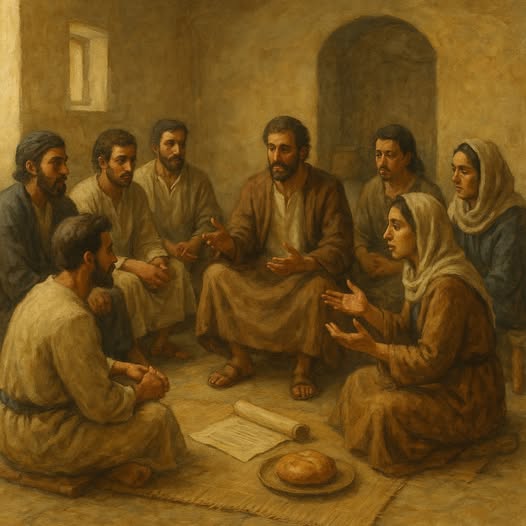
In some corners of Pre-Tribulation Rapture teaching, few verses are off-limits when it comes to finding evidence. The urgency to locate prophetic support sometimes leads interpreters beyond the apocalyptic or didactic passages of Scripture into poetic books, especially when rich imagery is involved. One such example is Song of Solomon 2:10–13. To many readers, this passage is a celebration of spring and love. But to a few prophecy teachers, it is a veiled reference to the Rapture of the Church before the Tribulation begins. The text reads,
“My beloved spoke and said to me, ‘Arise, my darling, my beautiful one, come with me. See! The winter is past; the rains are over and gone. Flowers appear on the earth; the season of singing has come.’”
What appears to be a romantic call from a lover is interpreted by some as a divine call upward, an invitation to escape coming judgment, framed as a poetic parallel to 1 Thessalonians 4. The claim is that the beloved is Christ, the bride is the Church, and the change in seasons reflects a transition from tribulation to peace. But this interpretation isn’t based on anything in the text itself. It’s not what the original author meant, not what the context supports, and not how Scripture teaches us to handle poetic literature.
Context, Genre, and the Nature of the Song
Song of Solomon is wisdom literature. It is a series of lyrical exchanges between lovers, celebrating covenantal desire and the beauty of intimacy. It is not apocalyptic, not prophetic, and not part of a discourse on the end of the age. The Jewish tradition has long seen the Song as a metaphor for Yahweh’s relationship with Israel, while early Christian theologians often allegorized it as Christ’s love for the Church. But these readings were devotional, not predictive.
They were reflections on the depth of God’s relational commitment to His people, not attempts to map out an eschatological timeline. The shift from winter to spring, in its own context, is not a coded reference to tribulation followed by rescue. It is part of the natural backdrop of renewal and growth, setting the stage for love to bloom. The invitation to “arise” and “come away” is an expression of longing and nearness, not a theological announcement. It is romantic, not apocalyptic.
Misusing Allegory to Prop Up Doctrine
At the heart of this misreading is a habit that plagues many popular-level interpretations, the overuse of allegory to force a text into a theological system. Allegory has a long tradition in Christian interpretation, but when used without restraint or discipline, it becomes a tool for inserting meaning rather than discovering it. In this case, the desire to find Rapture imagery leads to a reading that ignores genre, context, original audience, and linguistic nuance. There is no mention of clouds, no sound of a trumpet, no resurrection of the dead, and no gathering of the saints.
None of the key elements that define Rapture passages in the New Testament are present. The Hebrew phrase translated “come away” bears no relation to the Greek word harpazō used in 1 Thessalonians 4. The context is love and pursuit, not deliverance from judgment. To read a Pre-Tribulation Rapture into this passage is not merely a stretch. It is a disservice to the poetry itself and to the people reading it for hope and truth.
The Real Beauty in the Passage
The tragedy in all of this is that the real beauty of Song of Solomon 2:10–13 is lost when it is reduced to a speculative timeline. This is a moment of longing and union, a glimpse of the kind of faithful love that God designed to exist between husband and wife, and by extension, between Himself and His covenant people. It is not about escape but about embrace. The call to “arise” is not a rescue from suffering, but an invitation into joy. The winter is past. The rains are over. The time for singing has come.
This isn’t a coded message for the Church to disappear. It is a poetic celebration of love breaking through in its proper season. For believers, the richness of this book is found not in hidden clues about the end times but in its honest, God-honoring depiction of desire, fidelity, and relational pursuit.
Why It Still Gets Quoted
Despite its clear genre and intent, this passage continues to circulate in some circles as a Rapture reference because of a larger pattern, a willingness to find prophetic meaning in any passage that fits an emotional narrative. The poetic language is beautiful, the invitation is tender, and the idea of being called away before a dark time is comforting. But that does not make it true. The Church does not need to depend on hidden verses or emotional impressions to shape doctrine. God has not spoken in riddles.
The Scriptures dealing with Christ’s return, the resurrection of the dead, and the endurance of the saints are not hidden in metaphor or wrapped in wedding language. They are explicit, grounded, and situated in historical, prophetic, and apocalyptic literature. Using a passage like Song of Solomon 2 to defend a system undermines both the system and the Scripture it’s trying to use.
Conclusion
Song of Solomon 2:10–13 is not a picture of the Rapture. It is not a promise of escape or a call to vanish before judgment. It is not even written in a genre where such things should be expected. It is, however, a stunning picture of love pursued and love returned. It is a celebration of beauty after barrenness, of covenantal intimacy after absence. To impose a Pre-Tribulation framework on this is not just incorrect. It diminishes the richness of what the text actually offers. The Church doesn’t need to mine love poetry for eschatology. Let the song be the song. It was never meant to be anything else.
Discussion Questions
- Why is it important to consider genre when interpreting a biblical passage, especially when forming theological doctrines?
- What are the potential dangers of using allegory to support prophetic or doctrinal claims not clearly present in the text?
- How does the misinterpretation of Song of Solomon 2:10–13 as a Rapture passage affect our understanding of both the text and the Rapture itself?
- In what ways does the actual message of Song of Solomon 2:10–13 offer spiritual richness that is lost when it is reduced to eschatological speculation?
- What does this example teach us about how to responsibly handle poetic and romantic texts in the Bible within broader theological conversations?
Want to Know More
- Tremper Longman III, Song of Songs (New International Commentary on the Old Testament, Eerdmans, 2001)
A scholarly yet accessible commentary that treats the Song as a poetic celebration of human love. Longman explores the structure and imagery of the text without reading into it apocalyptic meaning. His approach helps anchor interpretation in context and genre. - Richard S. Hess, Song of Songs (Baker Commentary on the Old Testament Wisdom and Psalms, Baker Academic, 2005)
Hess provides a detailed linguistic and literary analysis of the Hebrew text. He focuses on how the poetry functions in its ancient context rather than assigning speculative doctrinal meaning. This is a solid evangelical treatment for readers who want depth without eisegesis. - Michael S. Heiser, The Bible Unfiltered: Approaching Scripture on Its Own Terms (Lexham Press, 2015)
Heiser offers a strong defense of interpreting Scripture within its original framework. His emphasis on authorial intent, genre awareness, and responsible interpretation is especially helpful when evaluating popular but misplaced theological claims. - Gordon D. Fee and Douglas Stuart, How to Read the Bible for All Its Worth (Zondervan, 4th Edition, 2014)
A foundational resource on biblical interpretation. This book equips readers to navigate different literary genres and explains why reading poetry like prophecy leads to confusion. Their section on allegory is particularly relevant to avoiding abuse of passages like Song of Solomon. - Tom Gledhill, The Message of the Song of Songs (Bible Speaks Today Series, IVP Academic, 2005)
Written in a more devotional style, Gledhill still maintains sound hermeneutics. He honors the relational and covenantal themes in the text without overreaching. This is a good companion for readers who want theological insight without turning poetry into prediction.






